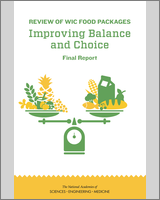From: 2, The WIC Program: Changes Since the Last Review and Continuing Challenges

Review of WIC Food Packages: Improving Balance and Choice: Final Report.
National Academies of Sciences, Engineering, and Medicine; Health and Medicine Division; Food and Nutrition Board; Committee to Review WIC Food Packages.
Washington (DC): National Academies Press (US); 2017 May 1.
Copyright 2017 by the National Academy of Sciences. All rights reserved.
NCBI Bookshelf. A service of the National Library of Medicine, National Institutes of Health.